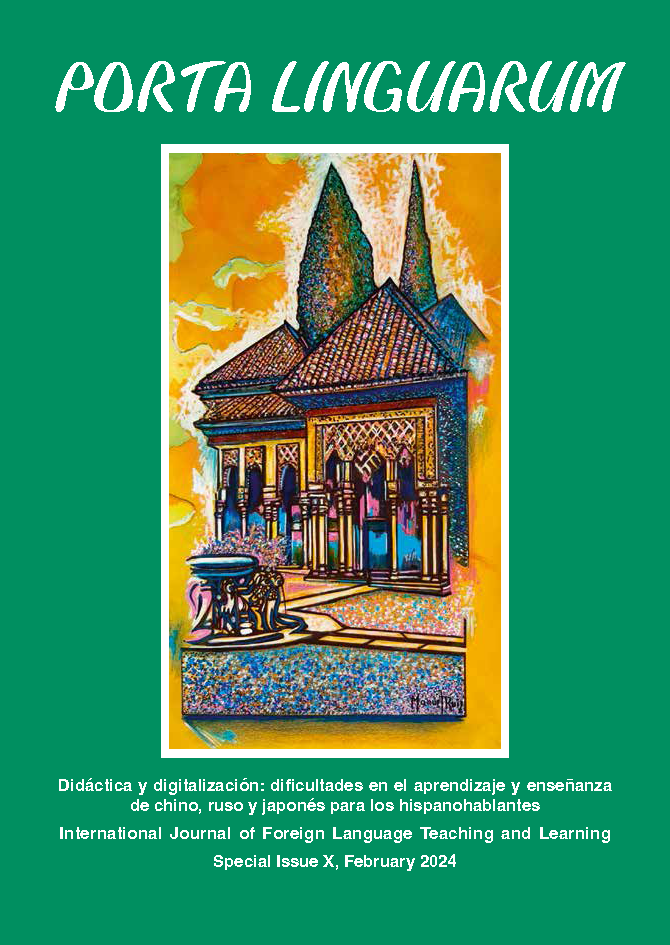The effect of task-supported and task-based teaching on the use of Russian verbs of motion
DOI:
https://doi.org/10.30827/portalin.viX.27844Keywords:
task-based language teaching, task-supported language teaching, Russian as a foreign language, verbs of motion, Learning Management SystemsAbstract
The goal of this investigation is to determine to what extent task-supported (TS) and task-based (TB) language teaching approaches are effective for learning Russian verbs of motion. To this aim, an experimental study was carried out under real classroom conditions as a part of Russian language courses at the University of ***. Participants were organised into two groups that received a TS and a TB treatment, respectively. The implementation of the didactic strategies subsumed in the design of the TB treatment by means of a Learning Management System (Moodle), the benefits and key features of which facilitate task-based instruction, are analysed. The study follows the pre-test, post-test and delayed post-test design. In the light of the results obtained, it is safe to say that the two approaches are beneficial for learning verbs of motion since both groups showed a significant improvement in all the measured aspects, that is, the correct use of verbs both in the oral and written production and in the grammar tests (fill in the blanks, multiple choice and grammaticality judgement tests). Nevertheless, the TB group performed significantly better than the TS group in the oral tasks, and in most delayed post-tests
Downloads
References
Andringa, S. & Curcic, M. (2015). How explicit knowledge affects online L2 processing: Evidence from differential object marking acquisition. Studies in Second Language Acquisition, 37(2), 237–268. https://doi.org/10.1017/S0272263115000017
Ahmadian, M. J. & Long, M. (Eds.) (2020). The Cambridge handbook of task-based language teaching. Cambridge University Press.
****(2001)****
Comer, W. J. (2007). Implementing task-based language teaching from the ground up: Consideration for lesson planning and classroom practice. Russian Language Journal, 57, 181‒203. https://www.jstor.org/stable/i40147394
Denhovska, N. & Serratrice, L. (2017). Incidental learning of gender agreement in L2. Journal of Psycholinguistic Research, 46(5), 1187–1211. https://link.springer.com/article/10.1007/s10936-017-9487-x
Doughty, C. (2003). Instructed SLA: Constraints, compensation, and enhancement. In C. Doughty and M. Long (Eds.), The handbook of second language acquisition (pp. 256–310).
Ellis, R. (2003). Task-based language learning and teaching. Oxford University Press.
Ellis, R., Li, S., & Zhu, Y. (2019). The effects of pre-task explicit instruction on the performance of a focused task. System, 80, 38–47.
Field, A. (2009). Discovering statistics using SPSS: And sex and drugs and Rock’n’roll. Sage publications.
***(2019)***
González-Lloret, M. & Nielson, B. (2015). Evaluating TBLT: The case of a task-based Spanish program. Language Teaching Research, 19(5), 525–549. https://doi.org/10.1177/1362168814541745
González-Lloret, M. (2015). A practical guide to integrating technology into task-based language teaching. Georgetown University Press.
Gor, K. & Jackson, S. (2013). Morphological decomposition and lexical access in a native and second language: A nesting doll effect. Language and Cognitive Processes, 28, 1065‒1091. https://doi.org/10.1080/01690965.2013.776696
Long, M. (1991). Focus on form: A design feature in language teaching methodology. In K. de Bot, D. Coste, R. Ginsberg, & C. Kramsch (Eds.), Foreign language research in cross-cultural perspective (pp. 39‒52). John Benjamins.
Long, M. (2015). Second language acquisition and task-based language teaching. Wiley-Blackwell.
Long, M., Gor, K., & Jackson, S. (2012). Linguistic correlates of second language proficiency: Proof of concept with ILR 2‒3 in Russian. Studies in Second Language Acquisition, 34(1), 99–126. https://doi.org/10.1017/S0272263111000519
Loschky, L. & Bley-Vroman, R. (1993). Grammar and task-based methodology. In G. Crookes & S. M. Gass (Eds.), Tasks and language learning. Integrating theory and practice (pp. 123‒167). Multilingual Matters.
*******(2019)******.
Nielson, K. (2014). Evaluation of an online, task-based Chinese course. In M. González-Lloret & L. Ortega (Eds.), Technology-mediated TBLT. Researching technology and tasks (pp. 295‒321). John Benjamins.
Quero Gervilla, A. (2004). Análisis de errores e interlengua en la adquisición de las preposiciones en ruso por hispanohablantes. Cuadernos de Rusística Española, 1, 89–104. https://doi.org/10.30827/cre.v1i0.1860
Robinson, P. (1996). Learning simple and complex second language rules under implicit, incidental, rule-search, and instructed conditions. Studies in Second Language Acquisition, 18(1), 27–67. https://doi.org/10.1017/S0272263100014674
****(2002)****.
Samuda, V. & Bygate, M. (2008). Tasks in second language learning. Palgrave Macmillan.
Shintani, N. (2011). A comparative study of the effects of input-based and production-based instruction on vocabulary acquisition by young EFL learners. Language Teaching Research, 15(2), 137–158. https://doi.org/10.1177/1362168810388692
Skehan, P. (1998). Task-based instruction. Annual Review of Applied Linguistics, 18, 268‒286. https://doi.org/10.1017/S0267190500003585
Van de Guchte, M., Rijlaarsdam, G., Braaksma, M., & Bimmel, R. (2019). Focus on language versus focus on content in the pretask: Effects of guided peer-video model observations on task performance. Language Teaching Research, 23(3), 310–329. https://doi.org/10.1177/1362168817735543
Van den Branden, K. (2006). Introduction: Task-based language teaching in a nutshell. In K. Van den Branden (Ed.), Task-based language education: From theory to practice (pp. 1‒16). Cambridge University Press.



















